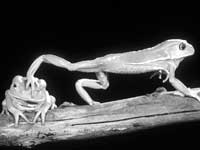
Frogs (Ribbit) at AMNH
by Joanna Leefer
Frogs: they come in
all sizes and shapes, and live in all types of habitats from
jungle wetlands to parched deserts. Frogs have captivated
the imagination of people throughout the centuries. Did you
know that frogs can live as long as 20 years or more? That
they drink through the skin of their bellies? That the world’s largest frog, the goliath frog
of West Africa, can grow to 15 inches and weigh up to 7 pounds,
the weight of a newborn infant? And that some frogs are so
poisonous, they can kill a human. Now through October 3, 2004,
people have the chance to learn more about frogs at the American
Museum of Natural History’s new exhibit, Frogs: A
Chorus of Colors. This enchanting new exhibition features over 200 live
frogs from 17 countries. The frogs have been gathered from
as far away as Argentina, Brazil, China, Kenya, Nicaragua,
Russia, Suriname, and Viet Nam. The exhibit explores the evolution
and biology of frogs, notes their important role as a barometer
to changes in the ecosystem, and discusses how they are being
used in scientific studies.
The museum has re-created
the habitat of different frogs, from tropical wetlands to
deserts. In addition to frog habitats, the museum has created
interactive stations throughout the exhibit where people
can activate recordings of frog calls, and view videos of
frogs eating and jumping. The centerpiece of the exhibition
features a 110 cubic foot vivarium that encases over 75 poisonous frogs.
Most of these frogs can be identified by their bright colors
that warn predators of their toxic skins, making this enclosure
a vibrant array of neon reds, blacks, and gold colors.
The exhibit explains
the importance of frogs to our society. Frogs have been a
valuable food source for many impoverished nations. They
have also become a delicacy for many developed countries.
In the U.S. alone, over 1.25 million pounds of frogs legs
are imported every year. Frogs are proving to be a valuable
source of medical care. Scientists studying frog toxins are
discovering they can be applied in human medicine to treat
such ailments as heart disease, depression, skin and colon
cancer, and even Alzheimer’s. One poisonous frog
from Ecuador and Peru has even been found to secrete a painkiller
called eipibatideine that is 200 times more powerful than morphine
and appears to be non-addictive.
In addition to the exhibit,
the American Museum Of Natural History is presenting a series
of lectures on frogs, covering everything from frog songs,
to extreme frogs—cannibalistic
frogs, dart poison frogs, and frogs that exist in the desert.
There are two children’s workshops—one on frog
wire sculptures, and on the metamorphoses of tadpole to frog.
The Museum is also opening The Frog Shop that offers an array
of fun frog-themed merchandise including bath accessories,
housewares, novelty toys, and books and CDs.#
